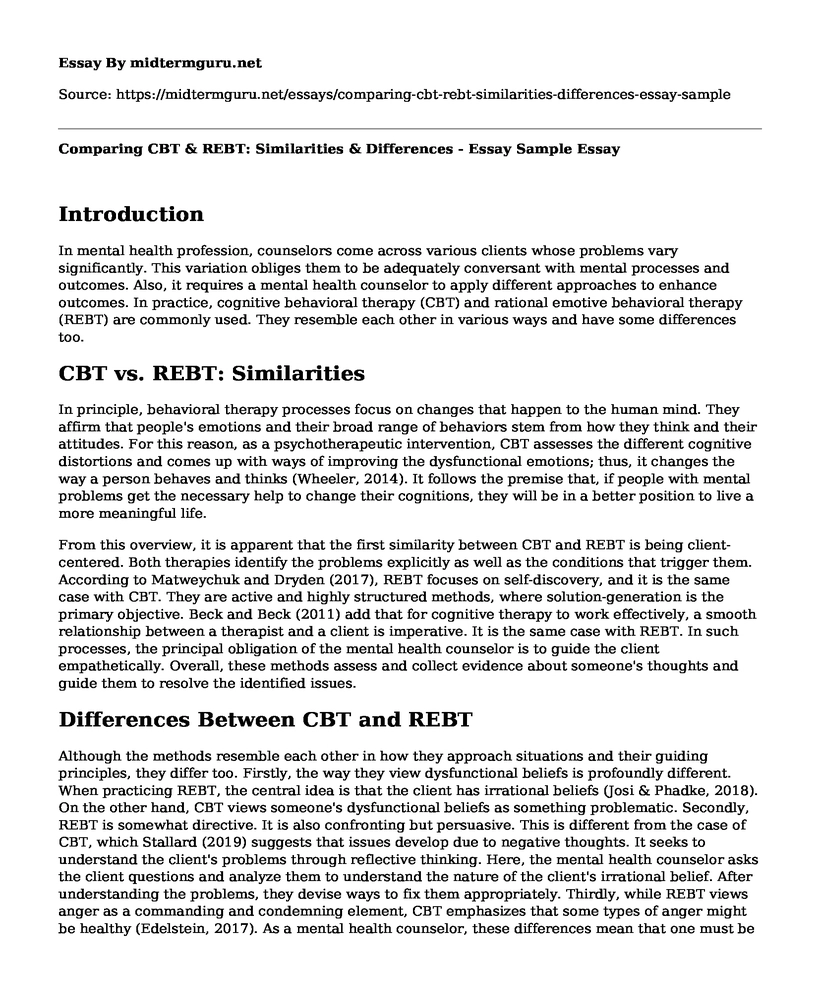Introduction
In mental health profession, counselors come across various clients whose problems vary significantly. This variation obliges them to be adequately conversant with mental processes and outcomes. Also, it requires a mental health counselor to apply different approaches to enhance outcomes. In practice, cognitive behavioral therapy (CBT) and rational emotive behavioral therapy (REBT) are commonly used. They resemble each other in various ways and have some differences too.
CBT vs. REBT: Similarities
In principle, behavioral therapy processes focus on changes that happen to the human mind. They affirm that people's emotions and their broad range of behaviors stem from how they think and their attitudes. For this reason, as a psychotherapeutic intervention, CBT assesses the different cognitive distortions and comes up with ways of improving the dysfunctional emotions; thus, it changes the way a person behaves and thinks (Wheeler, 2014). It follows the premise that, if people with mental problems get the necessary help to change their cognitions, they will be in a better position to live a more meaningful life.
From this overview, it is apparent that the first similarity between CBT and REBT is being client-centered. Both therapies identify the problems explicitly as well as the conditions that trigger them. According to Matweychuk and Dryden (2017), REBT focuses on self-discovery, and it is the same case with CBT. They are active and highly structured methods, where solution-generation is the primary objective. Beck and Beck (2011) add that for cognitive therapy to work effectively, a smooth relationship between a therapist and a client is imperative. It is the same case with REBT. In such processes, the principal obligation of the mental health counselor is to guide the client empathetically. Overall, these methods assess and collect evidence about someone's thoughts and guide them to resolve the identified issues.
Differences Between CBT and REBT
Although the methods resemble each other in how they approach situations and their guiding principles, they differ too. Firstly, the way they view dysfunctional beliefs is profoundly different. When practicing REBT, the central idea is that the client has irrational beliefs (Josi & Phadke, 2018). On the other hand, CBT views someone's dysfunctional beliefs as something problematic. Secondly, REBT is somewhat directive. It is also confronting but persuasive. This is different from the case of CBT, which Stallard (2019) suggests that issues develop due to negative thoughts. It seeks to understand the client's problems through reflective thinking. Here, the mental health counselor asks the client questions and analyze them to understand the nature of the client's irrational belief. After understanding the problems, they devise ways to fix them appropriately. Thirdly, while REBT views anger as a commanding and condemning element, CBT emphasizes that some types of anger might be healthy (Edelstein, 2017). As a mental health counselor, these differences mean that one must be conversant with the process and target outcomes of each model. Different cases will also necessitate the use of a specific model hence the need for being dynamic in practice.
Preferable Method
After a close analysis of the methods, I prefer CBT over REBT. The main reason is the fact that its theorists contend that dysfunctional thoughts are problems; this is because they interfere with someone's cognitive processes (Stallard, 2019). As a result, the approach is more holistic, unlike the case of REBT that strives to convince clients that examines the irrationality of the client's beliefs.
As this discussion shows, people thought processes change due to many factors. This alteration goes further to affect their attitudes and feelings, but unless their problems are understood from a professional point of view, it is impossible to give them the appropriate help. Despite their differences, CBT and REBT are practical intervention measures. They assess the cause of the mental health concern and intervene accordingly.
References
Beck, J. S., & Beck, J. S. (2011). Cognitive behavior therapy: Basics and beyond. Guilford Press.Edelstein, M. R. (2017, Mar 14). 5 Major Differences Between REBT & CBT. Psychology Today. Retrieved from https://www.psychologytoday.com/intl/blog/the-three-minute-therapist/201703/5-major-differences-between-rebt-cbt
Josi, A., & Phadke, K. M. (2018). Rational emotive behaviour therapy integrated. SAGE Publications.
Matweychuk, W. J., & Dryden, W. (2017). Rational Emotive Behaviour Therapy: A Newcomer's Guide. Routledge.
Stallard, P. (2019). Think Good, Feel Good: A Cognitive Behavioural Therapy Workbook for Children and Young People. Wiley.
Wheeler, K. (Ed.). (2014). Psychotherapy for the advanced practice psychiatric nurse: A how-to guide for evidence-based practice (2nd ed.). Springer Publishing Company.
Cite this page
Comparing CBT & REBT: Similarities & Differences - Essay Sample. (2023, Jan 23). Retrieved from https://midtermguru.com/essays/comparing-cbt-rebt-similarities-differences-essay-sample
If you are the original author of this essay and no longer wish to have it published on the midtermguru.com website, please click below to request its removal:
- Articles Analysis Essay on Depression
- Physical Activity and Inactivity on Oxidative Stress - Paper Example
- Definition Essay on Vaccination
- Mental Health: Its Impact on Development, Childhood, Adolescence & Adulthood - Essay Sample
- Nurse's Role in Achieving Patient Compliance in California - Essay Sample
- Essay Sample on Harvesting Embryonic Stem Cells for Medical Research
- APNs: Combining Nursing & Physician Skills for Exceptional Care - Essay Sample







